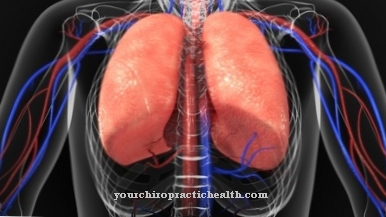Of the Wartenberg reflex is a reflex from the group of pathological reflexes. It belongs to the pyramid orbit signs and thus provides indications of a disease of the nervous system.
What is the Wartenberg reflex?

The Wartenberg reflex is also called Wartenberg sign known. It was named after the American neurologist Robert Wartenberg. Similar to the Gordon finger spreading sign and the Trömner reflex, the Wartenberg reflex is one of the pyramidal trajectories of the upper extremity.
It is positive when the thumb hits two, three, and four against resistance when the fingers are bent, and occurs almost exclusively in the case of a lesion of the pyramidal tract.
Function & task
The pyramidal orbit is part of the pyramidal system (PS). In its entirety, the pyramidal system is responsible for voluntary motor skills and fine motor skills. The central motor neurons are located in the primary motor cortex in the brain. Motor neurons are nerve cells that supply the body's muscles with nerves. They are the basis of muscle contractions in the active skeletal muscles. The nerve fibers of these central motor neurons run from the cortex over the brain stem and spinal cord to the lower motor neuron.
The entirety of these motor neurons and their nerve fibers is known as the pyramidal tract. In the area of the pyramid crossing, at the transition from the brain to the spinal cord, more than 80% of the nerve fibers cross to the other side. The functionality of the pyramidal path can therefore be tested with the aid of the pyramid trajectory signs.
Pyramidal tract signs are reflexes or involuntary, rhythmic muscle contractions (cloni) that, when seen in adults, are pathological. In infants, these phenomena are physiological, as the pyramidal tracts are not yet fully developed.
With the Wartenberg sign, the index finger, middle finger and ring finger are actively bent against resistance. If the Wartenberg sign is negative, nothing else happens. With a positive Wartenberg sign, on the other hand, the thumb bends into the palm of the hand. One speaks here of a pathological movement of the thumb.
The Wartenberg sign is performed with the other hand in a side-by-side comparison. A positive Wartenberg sign is to be interpreted as an indication of a lesion of the pyramidal tract.
You can find your medication here
➔ Medicines for paresthesia and circulatory disordersIllnesses & ailments
Pyramidal orbital signs often occur with unilateral damage to the pyramidal system. The most common cause of such a unilateral lesion is a stroke. A stroke is a disorder of the brain and central nervous system caused by a decreased blood supply to the brain. Stroke is the third most common cause of death in Germany and the most common cause of moderate and severe physical disabilities. In the event of a stroke, the nerve cells suddenly receive too little oxygen. This is usually caused either by a vascular occlusion (ischemic insult) or an acute cerebral hemorrhage (hemorrhagic insult). The crossing of the pyramids usually leads to paralysis on the opposite side of the body. For example, if the infarction occurred in the right hemisphere, a positive Wartenberg sign on the left side may indicate a lesion in the right hemisphere.
Other symptoms that indicate a stroke are visual disturbances in one or even both eyes, double vision, visual field loss, dizziness, nausea, vomiting, gait disorders, weakness, severe headache, difficulty swallowing (dysphagia) or disorientation. Complete paralysis only occurs in rare cases. The so-called extrapyramidal control usually persists and can take over some functions.
A positive Wartenberg reflex can also occur in multiple sclerosis. Multiple sclerosis is a chronic disease of the nervous system. The myelin sheaths of the nerve fibers are particularly affected. Many nerve fibers are covered with an insulating layer for faster stimulus transmission. This layer is also known as the myelin sheath or myelin sheath. In multiple sclerosis, these medullary sheaths develop numerous foci of inflammation that lead to degeneration of the insulating layer. One speaks here of multiple demyelinating foci. The white matter of the brain and spinal cord, and thus also the pyramidal tract, is primarily affected.
However, since the inflammation of the nerves can occur throughout the nervous system, multiple sclerosis can cause almost any neurological symptom. At the beginning of the disease there are mostly visual and sensory disturbances. A typical symptom is double vision. Sensitivity disorders such as abnormal sensations, pain or numbness occur in the legs and hands. If the motor system is involved, paralysis of the extremities also occurs. However, the symptoms are not always clear. Therefore, a positive Wartenberg sign should always make you think of multiple sclerosis.
A disease in which a positive Wartenberg reflex can also occur is multiple system atrophy. It is a neurodegenerative disease that progresses rapidly and affects different systems at the same time. The disease usually occurs between the ages of 40 and 60. In addition to the positive pyramidal signs, there are mainly extrapyramidal motor symptoms such as tremors (tremor) or muscle rigidity (rigidity). Cerebellar symptoms such as nystagmus or unsteady walking and standing can also occur. Swallowing disorders, speech disorders, urinary incontinence and erectile dysfunction are also observed in the affected patients. Often those affected also suffer from depression.
























.jpg)



